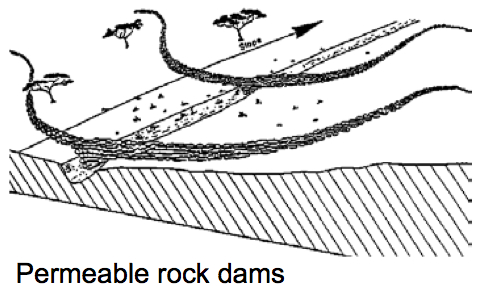Difference between revisions of "Water Portal / Rainwater Harvesting / Groundwater recharge / Permeable rock dams"
(→Construction, operations and maintenance) |
(→Acknowledgements) |
||
| Line 34: | Line 34: | ||
==Acknowledgements== | ==Acknowledgements== | ||
| + | * Rufino, L., [http://www.google.com/url?sa=t&rct=j&q=&esrc=s&source=web&cd=2&ved=0CFkQFjAB&url=http%3A%2F%2Fwww.saiplatform.org%2Fuploads%2FModules%2FLibrary%2FSAI%2520Technical%2520Brief%25205%2520%2520The%2520Importance%2520of%2520Soil%2520to%2520Water%2520Use.pdf&ei=gf91T6GYJ-jWiAK7zuGnDg&usg=AFQjCNFDyR4mjTVCcvvTt-9v4OrxAZQfDA&sig2=iMzgbW0eK395na_V_YA4Kw ''Water Conservation Technical Briefs: TB 2 – Rainwater Harvesting and Artificial Recharge to Groundwater'']. Sustainable Agriculture Initiative (SAI). August 2009. | ||
| + | * Awulachew, Seleshi Bekele (IWMI); Lemperiere, Philippe (IWMI); Tulu, Taffa (Adama University). [http://www.ilri.org/InfoServ/Webpub/fulldocs/IWMI_IPMSmodules/Module_2.pdf Water harvesting and development for improving productivity.] | ||
Revision as of 03:09, 1 May 2012
Permeable rock dams consist of long, low rock walls with level crests along the full length across valley floors. This causes runoff to spread laterally from the stream course. This is a floodwater harvesting technique that spreads and retains floodwater runoff for improved crop growth, as well as controls gulley erosion. Permeable rock dams can be considered a form of ‘terraced wadi’, though the latter term is normally used for structures within watercourses in more arid areas.
Contents
Suitable conditions
Permeable rock dams for crop production can be used under the following conditions:
- Rainfall: 200–750 mm; from arid to semi-arid areas.
- Soils: All agricultural soils—poorer soils will be improved by treatment.
- Slopes: Best below 2% for most effective water spreading.
- Topography: Wide, shallow valley beds.
The main limitation of permeable rock dams is that they are particularly site-specific, and require considerable quantities of loose stone as well as the provision of transport.
This system is generally used across relatively wide and shallow valleys. This technology is appropriate for regions with less than 700 mm annual rainfall, where gullies are being formed in productive land. This is particularly suited to valley bottoms with slopes of less than 2%, and where a local supply of stones and the means to transport them is available.
| Advantages | Disadvantages/limitations |
|---|---|
| - Increased crop production and erosion control as a result of the harvesting and spreading of floodwater. - Improved land management as a result of the silting up of gullies with fertile deposits. |
- Reduced runoff velocities and erosive potentials. - High transportation costs. |
Construction, operations and maintenance
Each dam is usually between 50 and 300 m in length. The dam wall is usually 1 m in height within a gully, and between 80 and 150 cm in height elsewhere. The dam wall is also flatter (2:1) on the down slope side than on the upslope side (1:2), to give better stability to the structure when it is full. A shallow trench for the foundation improves stability and reduces the risk of undermining. Large stones are used on the outer wall and smaller stones internally.
Costs
A typical rock dam providing erosion control and water supplies to plots of 2 to 2.5 ha costs about US$500 to 650 for transportation of materiel and about 300 to 600 person days of labour.
References, videos, links
Acknowledgements
- Rufino, L., Water Conservation Technical Briefs: TB 2 – Rainwater Harvesting and Artificial Recharge to Groundwater. Sustainable Agriculture Initiative (SAI). August 2009.
- Awulachew, Seleshi Bekele (IWMI); Lemperiere, Philippe (IWMI); Tulu, Taffa (Adama University). Water harvesting and development for improving productivity.

